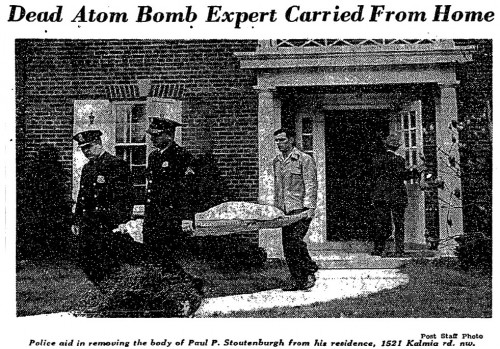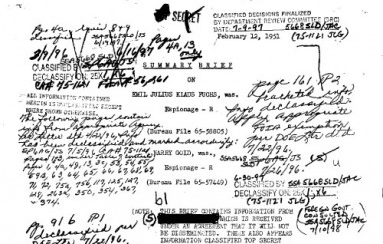 Alex Wellerstein is an historian of science at the American Institute of Physics with an obsession about the atomic bomb and in particular, about the patents taken out on it. Patents on the atomic bomb seem odd: apparently the government wanted to be sure it owned the rights, and not the “private contractors, private scientists, and universities” who actually designed and built the bomb.
Alex Wellerstein is an historian of science at the American Institute of Physics with an obsession about the atomic bomb and in particular, about the patents taken out on it. Patents on the atomic bomb seem odd: apparently the government wanted to be sure it owned the rights, and not the “private contractors, private scientists, and universities” who actually designed and built the bomb.
Anyway, in Wellerstein’s researches into the Manhattan Project’s patent office, he saw the name of a staffer named Captain Paul P. Stoutenburgh. Not that the name stood out, Wellerstein says. He was a guy doing his job, which would have entailed knowing the patentable details of the bomb. Nevertheless, as a good historian does, Wellerstein tracked down the documented particulars on Stoutenburgh from his birth, through his education, jobs, etc. etc., until his death. And then he did stand out. On April 1, 1946, he apparently shot first his wife and his 12-year old daughter and then himself. Word was that he had a “phobia,” that he’d been warning the War Department (the one we now call the Defense Department), that he was worried sick that bomb secrets were being leaked.
 Which they were.
Which they were.

 At the time, Klaus Fuchs, among others, was at Los Alamos working on the bomb and selling secrets to the Russians as fast as he could. Fuchs’ spying wasn’t discovered until much later but in that spring of 1946, a good bit of media coverage was about Russian-paid spies.
At the time, Klaus Fuchs, among others, was at Los Alamos working on the bomb and selling secrets to the Russians as fast as he could. Fuchs’ spying wasn’t discovered until much later but in that spring of 1946, a good bit of media coverage was about Russian-paid spies.
The press coverage of the Stoutenburghs’ deaths implied that Stoutenburgh, who may have tried to commit suicide the month before, was depressed, paranoid, and “couldn’t take it anymore.” But Wellerstein is an historian — “I poke around in these things compulsively,” he says, “it’s sort of my job” — and has a working knowledge of the Freedom of Information Act (FOIA), which he began using. The FBI’s reply was, he said, “Kafkaesque”: they had a file on Stoutenburgh but they destroyed it so they now don’t know what was in it. “Not so helpful,” says Wellerstein. The Washington, DC, Police Department also destroyed old records, as did the DC Coroner’s Office, case closed. “Army Intelligence had nothing on Stoutenburgh,” he said, “a FOIA to the National Archives turned up nothing.”
He thinks it odd, the lack of official reports of the death; he thinks that officials must have been “poking around” into an unusual death — “If you even sneezed near Los Alamos during World War II, the Manhattan Project security people would have opened a file on you” – and he should have found those reports. He did find two references to a possible conspiracy/cover-up. After the deaths, a contemporary former Marxist, anti-Communist, neo-conservative, political pundit was looking into the Stoutenburghs’ deaths and in the pundit’s papers, Wellerstein found reports of a phone conversation with someone whom the pundit believed knew a lot more than he was saying. And in other papers, Wellerstein found that some friend of some physicist had called a Congressional staffer, saying the physicist knew Stoutenburgh, knew that he had a gun that wasn’t the same calibre as the one used, that he was a poor shot, and that Stoutenburgh had told somebody who told somebody else that papers from his desk would disappear and then be returned. Not a 100-percent air-tight convincing case for a conspiracy, is it.
Wellerstein says, as does everybody else, that classification and secrecy come accompanied by talk of conspiracies. Inevitably, he says, the kind of secrecy that accompanied the building of the atomic bomb and secrecy in general “engenders this kind of speculation,” and “I wouldn’t be sending out Freedom of Information Act requests left and right if he didn’t have an atomic connection, either.” But any alternative conspiratorial scenario that he can think of for the Stoutenburghs’ deaths wouldn’t have a 100-percent air-tight convincing case either. In the end, he thinks it’s just another sad story in a world of sad stories. “One almost hopes there was something more sinister to it,” he says, “because it would keep it from seeming so pointlessly tragic. But pointlessly tragic is probably just what it was.”
And my own interest in it? I interviewed an old physicist who knew Klaus Fuchs, who had been at Los Alamos with him and who, along with a group of seven other scientists, for a year and a half ate three meals a day with Fuchs. “He was perfectly ok,” the old physicist said. “I mean, he wasn’t the funniest guy or anything. But I wouldn’t have suspected.” That is, sometimes bad things really are going on under the usual world. And another reason: Wellerstein is a beautifully-educated beautiful writer who calls himself an “archive rat,” and I love following somebody like that — with his FOIA’s and his documentary evidence and his common sense and his persistence –down the rabbit hole.
You will too. Go do it.
_________
Washington Post, April 1, 1946: via Wellerstein’s blog, Restricted Data
Federal Bureau of Investigation, “Summary Brief on Emil Julius Klaus Fuchs” (12 February 1951), (Excerpt), in Klaus Fuchs FBI file, FBI Vault version., via Restricted Data
These photos are from Wellerstein’s blog, not because I didn’t try to find others but because the others, especially ones about Fuchs, I did find which were in Creative Commons were also impossible to crop. But if you’re interested, here’s the ones from the FBI and the British MI5.
NB: The link at “go do it” is for the blog homepage. The permalink for the entry discussed is : http://nuclearsecrecy.com/blog/2013/03/15/death-of-a-patent-clerk/
Thanks for bringing this to my attention. Fascinating!